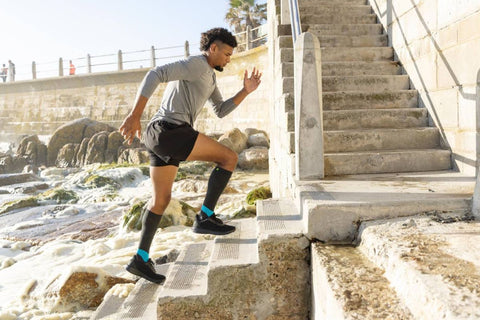Different running surfaces explained
Running on concrete
Concrete is among the most readily available running surfaces, especially for city dwellers. On top of that, it provides a smooth, flat, and predictable surface.
However, concrete is about the hardest surface you can run on. And especially if you’re looking to run fast or sprint train, it can seriously jolt your joints.
If you’re just out for a jog, slipping on a good pair of sneakers will generally offer sufficient shock absorption. Not to mention, the flat terrain means less strain on your Achilles tendon and less risk of tripping or twisting your ankle.
Running on grass
Grass is a lot softer than concrete, meaning your ankles, knees, and back have less shock to absorb. However, soft terrain does have its drawbacks.
For one, grass can be unpredictable; unlike concrete, it’s not always easy to tell where there are depressions in the ground. For two, the unsteady and squishy surface means your ankles will need to do a lot more work to stop themselves from twisting. As your heel is more liable to sink into the earth, there will also be more strain on your Achilles tendon.
Honourable mentions: track, trails, asphalt, and sand
Asphalt is also plentiful in cities and is a bit softer underfoot than concrete while providing a stable surface.
Track is built for speed. The rubberised, slightly squishy surface provides the best terrain for speed training, though running in loops can get a bit boring. You should also take care to switch directions, as the loops will put more pressure on one side of your body than the other.
Trails provide great scenery and are soft to run on. Frequently used trails will also be well-maintained and predictable, reducing your risk of painful injuries. Just bear in mind any water changes (e.g., rain) that might complicate your run.
Sand provides an excellent workout for your calves, especially if you run on the drier, deeper side. Wet sand also provides good resistance with less risk of injury. As with track, be sure to run in different directions. While sand doesn’t loop, it does slant.
Reduce shock and improve stability when running
No matter the terrain you choose, there are ways you can make running safer. Calf Compression Sleeves, for example, will reduce the impact of oscillations (the uncomfortable vibrations that shoot up your legs when your feet hit the ground). Compression also boosts circulation and activates the muscles, leading to reduced muscle fatigue and better awareness of how you step.
Our Performance Socks have the same benefit, with the addition of built-in supports for the Achilles and arches to achieve a more stable step.
And last but not least, our Run Performance Insoles will add an extra layer of protective cushioning, proprioception, and support.
Grass vs concrete: which is better for running?
At the end of the day, it really depends on your preferences and training. If you’d like to decrease the shock to your joints or get more of a workout at a shorter distance, grass is better. If your body doesn’t mind the shock or you’d like to run on safer and more predictable terrain (or you don’t have access to grass), concrete is better. And besides, you can always add an extra layer of protection through insoles or compression for safer running on your preferred terrain.





















